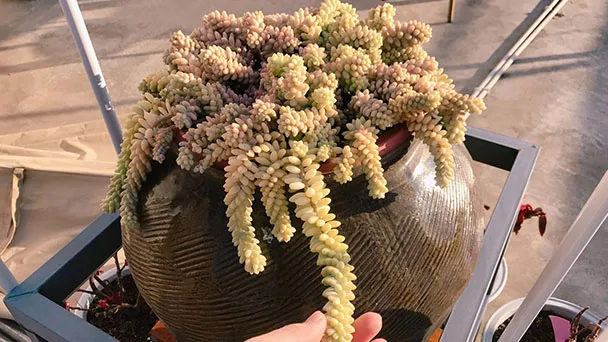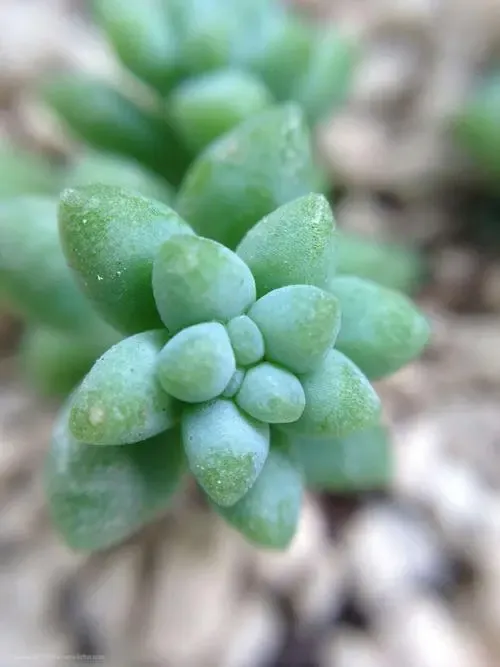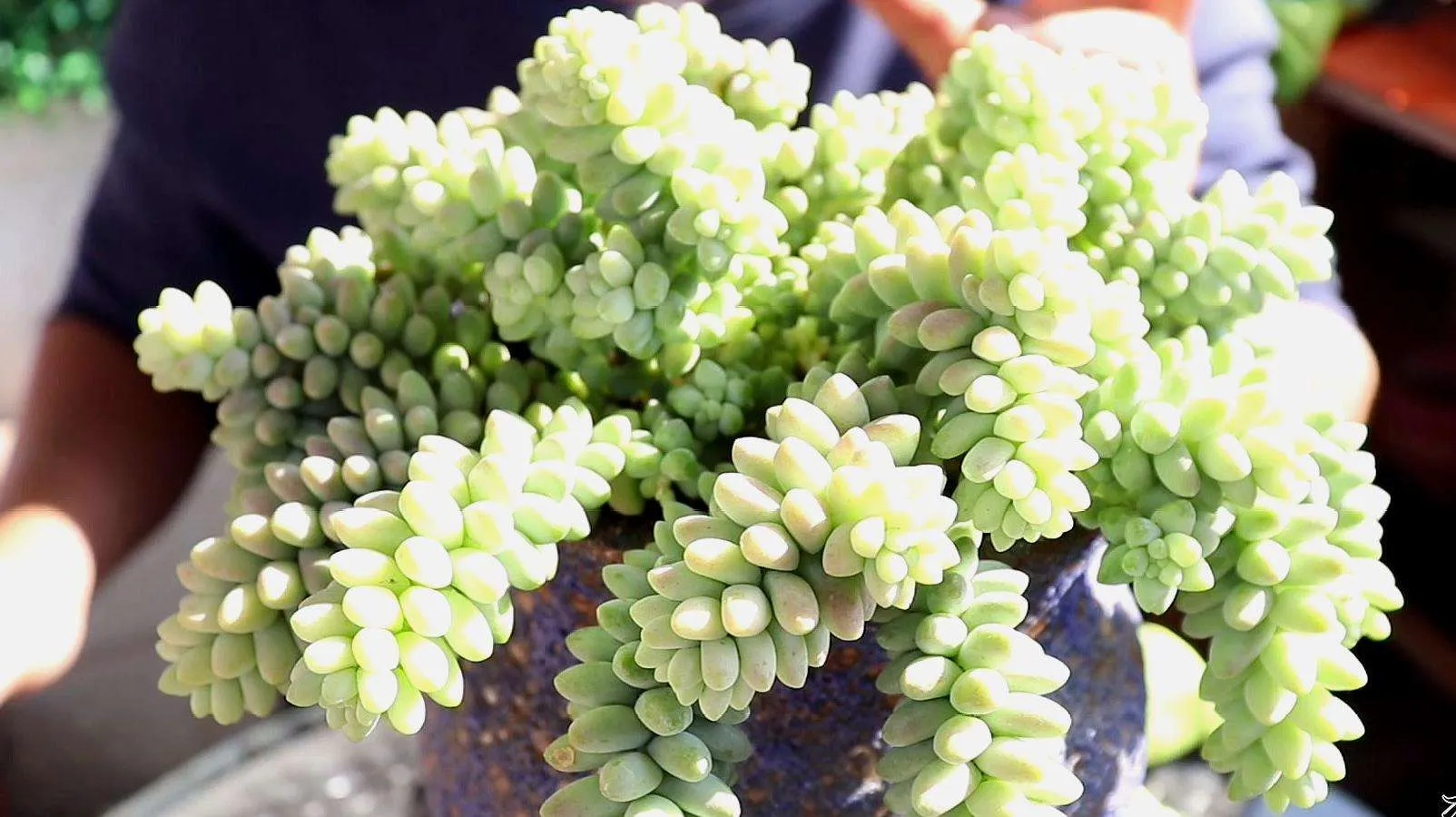How To Save My Overwatered Burros Tail
Written by Ivy
Dec 09 2022

The most typical symptoms of over-watering in a burro's tail will be discussed in this article, along with solutions. Let's start!
There are two situations in the overwatered burro's Tail:
- Leaves at the bottom turn into water or the whole leaves fall down.
- Roots rot directly and the stems rot black.

What Does an Overwatered Burro's Tail Look Like?
Because if the roots of succulent plants are relatively developed and we water too much, they can't absorb so much water. Too much water will cause the leaves under them to turn into water, which is a normal phenomenon and even cause the whole leaves to fall off. Because the water content in the plant is very large, he feels that he can't absorb too much water, The excess water can only be discharged by dropping the leaves. This situation is relatively good. If the soil you configure is not good, and the air permeability and water permeability are poor, it will appear rotten roots after watering more. After rotten roots, their roots are in the basin soil. If you can't find them, they will gradually rot from the bottom to the top, and finally, lead to the black stem of the whole plant. It's too late to treat them when they are found.How Do We Save an Overwatered Burro's Tail?

Root Pruning Disinfection
We can directly trim the rotten roots and the branches of overwatered burro's tail. The cut should be flat. After pruning, it should be disinfected in potassium permanganate or carbendazim solution. The main thing is to disinfect the trimmed wound to prevent the wound from being infected by bacteria.Root Hanging Basin
After disinfection, the root should be dried to let the wound of the flooded burro's tail dry naturally. Generally, it can be solved by drying the root one night in the summer. After drying the root, it is recommended to put it in a basin on wet soil. In summer, it is so weak and wrinkled and fleshy. It is not recommended to pour water through the root-fixing water after planting. It is recommended to put it in a basin on wet soil.Cooling and Slow Seedling Maintenance
Summer high temperatures, Burro's Tail will sleep after the temperature is higher than 33 degrees, so we can put Overwatered Burro's Tail in a cool and ventilated place to slow down seedling maintenance. After the temperature is high, we can quickly cool the moisture of the environment spray water. When we see the basin soil is dry, then water it, water it in summer, moisten it, do not irrigate it with water.How To Avoid Overwatering Your Burro's Tail

During the maintenance of burro's tail, water and fertilizer management shall also be done well. Burro's tail has certain drought resistance. The principle of seeing dry and seeing wet can be adopted during watering. During dormancy, the watering amount shall be reduced to ensure that the soil is slightly dry. During the growth of burro's tail, we can apply thin potassium fertilizer and phosphorus fertilizer every other month to supplement nutrition, so that burro's tail can grow vigorously.
In the process of curing burro's tail, we need to pay attention to ensuring the ventilation of the environment. If it is muggy in summer, it needs to be transferred to a ventilated and breathable environment for maintenance to avoid the overgrowth of burro's tail. When the air is dry, it is also necessary to often spray water around the leaves to moisturize, so that burro's tail can grow and develop healthily.
Read More:
- Why Are My Burro's Tail Shriveling?
- How Often To Water Burro's Tail
- Why My Burro's Tail Leaves Falling Off
- How Much Light Does Burros Tail Need?
- Burro's Tail VS Donkey Tail
- How Do I Make My Burro's Tail Bloom?
- How To Save Underwatered Burro's Tail
Remedy for Mildly Over-watered Burro's Tail
What you can and should do once you diagnose the over-watering in your plant depends on how much damage has been done. And that in turn depends on for how long have you been giving too much water to your Burro's Tail, but is also depends on how mature your plant is. Older mature plants are more versatile and they can survive over-watering for much longer than younger plants that simply lack robust and complex root system.
Anyway, if you spot the problem very early–like you over-watered your plant just for a week or two, or if you've done if for longer but we talk here about a mature healthy plant, the only remedy you have to take is stopping the watering until the soil is completely dry, and lessen your watering frequency.
You Should Always Start With Checking the Moisture of the Soil
Over-watering is the most common issue with burro's tail, but before you blame wrinkled leaves, or drooping plant, or changes of color to over-watering, you should always check the moisture of the soil first. Place a finger inside. If the soil is very moist and sticks to your finger, and you haven't watered the plant in a while, it is almost certainly overwatered.
Basic knowledge of the recommended watering frequency can also be useful in this situation. If you water your burro's tail twice a week and do not live in a summer in a desert, I almost guarantee that it has been overwatered. On the other hand, if you only water it once every two or three weeks, there is a chance that the issues you notice with the plant—shriveling leaves, color changes, strange odors, etc.—are due to something else—pests, sunburn, incorrect fertilizer use, under-watering, etc.
Severely Over-watered Burro's Tail Cannot Be Saved
There are certain instances in life when we simply have to accept a defeat, and move on. You may encounter such situations even with your succulents… What I try to say here is that when the entire plant is mushy or shriveled, when you for one reason or another haven't spot the problem earlier, you likely cannot save this exemplar of Burro's Tail anymore.
You can still attempt to remove it from the original pot and look for rot in the roots. Most likely though the entire rooting system will be irreversibly damaged and rotten, and in such a case you can just thank higher powers for this lesson, and move on. Not all battles can be won. As long as you learn from the experience, and do not repeat the same mistake with your new plant.
Latest Updated
- Benefits of Bugleweed - 7 Science-backed Health Benefits
- Bugleweed Dangers & Side Effects - Is It Poisonous?
- How to Plant Evergreen Trees - What You Should Know
- When to Plant Evergreens - Grow Guide for Evergreen Trees
- 12 Wonderful Evergreen Shrubs for Your Garden
- 12 Popular Evergreen Plants with Pictures for Beginners
- When And How To Prune A Lilac Bush Like a Pro
- How to Grow & Care for Lilac Vine (Hardenbergia Violacea)
- Japanese Lilac Tree (Syringa Reticulata) Care & Propagation Guide
- Shumard Oak Pros and Cons - What to Know
Popular Articles
- Winter maintenance of Antirrhinum Majus
- How to Grow Terminalia Mantaly Tree
- How to Grow and Care for Crossostephium Chinense
- How to grow Antirrhinum Majus in spring
- Peristeria Elata (Dove Orchid) Profile: Info & Care Guide
- Underwatered Snake Plant (Sansevieria Trifasciata) - Signs And How To Fix
- How to Care for Brazilian Jasmine Plant (Mandevilla Sanderi)
- How to Grow & Care for Graptopetalum Purple Delight in Summer
- Rosa Chinensis (China Rose): Plant Growing & Care Tips
- How to Care for Baby Sun Rose (Aptenia Cordifolia)